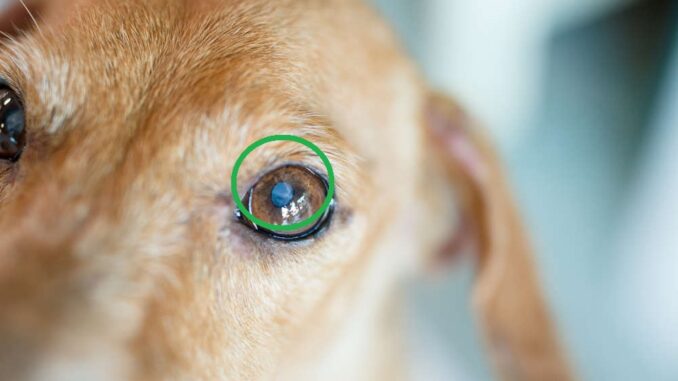
The presence of white, cloudy or gray-colored areas on the eye is not normal and can be an indication of a problem. These spots can either be harmless or serious, and if left untreated, they may lead to blindness over time.
To determine the underlying cause, you or your veterinarian can examine the size and character of the white or gray spots in your dog’s eye. Let’s take a look at the most common conditions that cause these white spots.
Top causes of white spots on a dog’s eyes
1. Cataracts
Cataracts are a common eye condition that can range from benign, causing minimal vision impairment, to serious, potentially leading to blindness if untreated. If only 30% of one eye is affected, your dog will probably have normal vision.

They can be hereditary or caused by a disease like diabetes. Either way, the lens of one or both eyes becomes cloudy-white. When dogs develop cataracts, you may notice your dog has:
- A white spot in the middle of the eye that may be pinpointed or grow to cover the entire eye
- Disorientation and confusion
- Poor depth perception
- Trouble bumping into things
- A tendency to become easily frightened
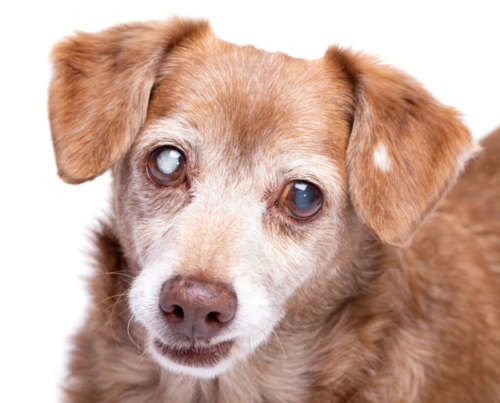
There is currently no medical treatment to delay cataracts in dogs, and it’s usually a progressive condition. The only option to restore your dog’s vision is the surgical removal of the lens by a veterinary ophthalmologist. Learn more about Cataracts.
2. Nuclear sclerosis:
Age-related bluish-gray haziness of the lens, often confused with cataracts but doesn’t significantly impair vision.
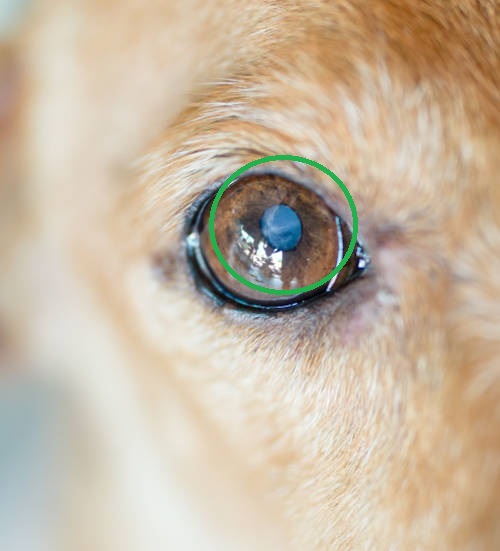
As dogs age, they may experience nuclear sclerosis. When this happens, the lens nucleus becomes opaque. Signs of the condition include:
- Cloudy or hazy eyes
- A bluish or gray tint in the center of the eye
- May affect one or both eyes
There is no treatment needed for nuclear sclerosis. Dogs generally don’t experience loss of vision from this condition, and it is considered a normal part of aging.
Learn more about Nuclear Sclerosis.
3. Corneal ulcers
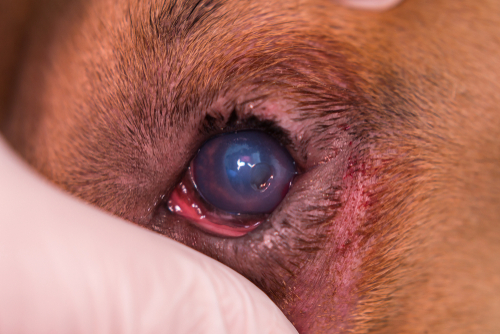
Corneal ulcers are open sore on the cornea, often painful, resulting from trauma or infection. A corneal ulcer is an erosion of the cornea that may be caused by trauma, dryness, infection, or other circumstances. When an ulcer forms, all or part of the cornea becomes cloudy due to fluid buildup from inflammation. In the early stages, the erosion may appear as a cloudy or whitish spot on the eye, as shown in the picture below.
Dogs with corneal ulcers may have:
- Redness around the eye
- Pain
- Excessive tearing
- Photosensitivity
- Pawing at the face
- Keeping the eye shut
Treatment for a mild ulcer usually involves the application of a broad-spectrum ophthalmic ointment and topical painkillers. If the ulcer is deep or complications arise, surgery may be necessary.
The prognosis for simple corneal ulcers is generally excellent. More complicated cases may require protracted or life-long treatment.
Learn more about Eye Ulcers (With Pictures).
4. Cholesterol deposits on the cornea
Whitish-yellow plaques on the corneal surface due to lipid accumulation. View pictures.
Round or oval-shaped white to grayish-white spots in your dog’s eye may be due to deposits of cholesterol in the cornea. It may be due to an inherited condition, elevated blood cholesterol levels, or corneal degeneration. Symptoms include:
- Usually, only one eye is affected
- Sparkly, crystalline, or shiny material in the eye
- It may include eye redness or cloudiness
The treatment for corneal lipidosis depends on the cause:
Congenital conditions: These don’t require treatment but should be monitored for the development of corneal ulcers
Corneal degeneration: In this case, the vet will treat the underlying condition with antibiotic eye drops, anti-inflammatory drops, pain medication, and artificial tears for dry eyes. When the condition is due to elevated cholesterol levels, treatment may include dietary management and supplements to reduce cholesterol.
The prognosis depends on the underlying cause but is generally favorable with the appropriate treatment.
5. Uveitis
Uveitis is a painful inflammation of the eye’s middle layer, causing redness and potential cloudiness.
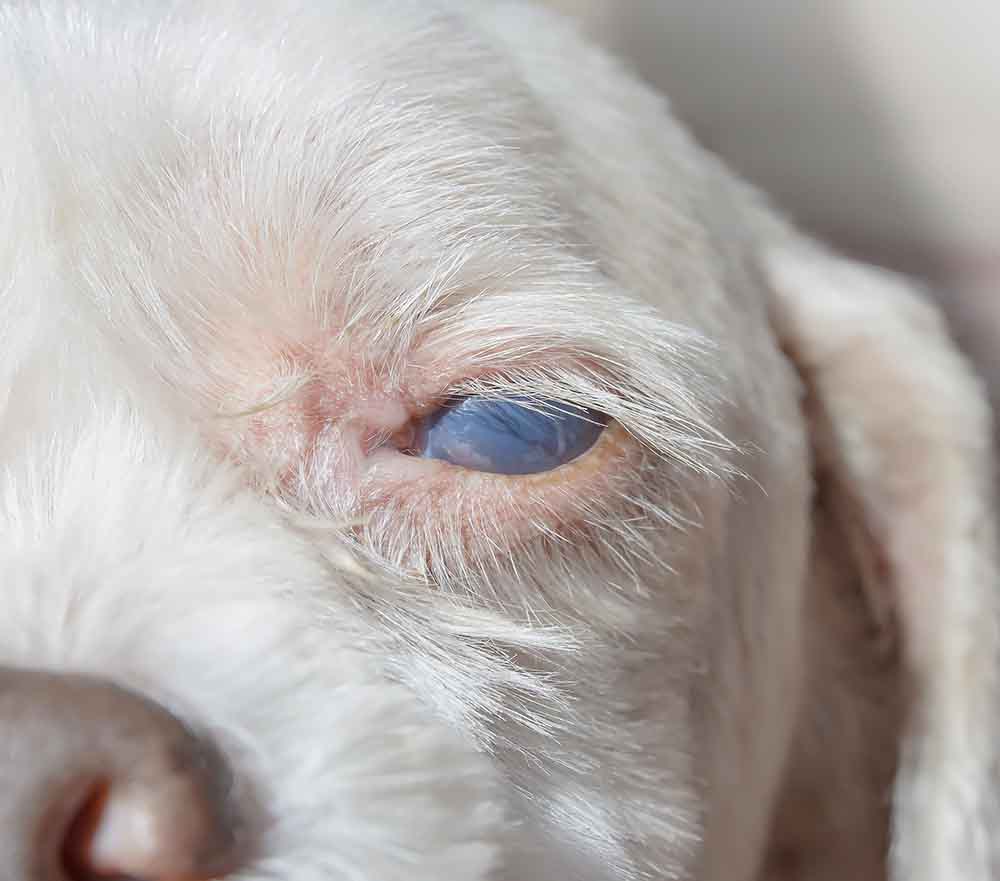
Inflammation of one or more parts of the uvea can cause a red or cloudy appearance in the center of the eye. Depending on how much of the uvea is involved, there may be brown spots, one cloudy spot, or a larger disc. Symptoms include:
- Red eye
- Squinting
- Pain
- Photosensitivity
- Excessive tearing
- Cloudy or bluish cornea
- Blood or pus
Treatment can vary depending on the cause and may include:
- Topical steroids
- Non-steroidal anti-inflammatory eye drops
- Repair of corneal tears
- Removal of foreign bodies
The prognosis for uveitis is usually favorable with early treatment. If the condition is severe or recurrent, it may however cause blindness. Learn more.
6. Corneal endothelial degeneration
Corneal endothelial degeneration is progressive damage to the innermost corneal layer, leading to corneal thickening and clouding.
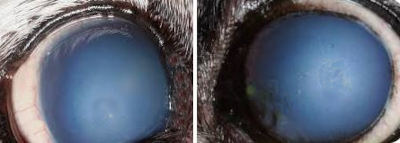
This condition often occurs in middle-aged to older dogs and can be a result of aging, genetic factors, or secondary to other eye diseases. Symptoms include a bluish or grayish discoloration of the cornea, vision impairment, and potential discomfort. Treatment focuses on managing underlying causes and relieving symptoms, as the degeneration itself is irreversible. Learn more.
When are spots in my dog’s eye a reason for concern?
Many of the conditions we described share common symptoms, so it can be difficult to discern harmless conditions from serious health threats. If you notice new spots or cloudiness in your dog’s eye(s), you should contact your veterinarian. Bring your pooch to the vet if you notice symptoms like:
- Bumping into things in the house
- Inflamed, irritated eyes
- Anxiety or hesitation in unfamiliar surroundings
- Easily startled
- Rubbing
- Squinting or sensitivity to light
- Bulging eyes
When are they likely NOT a cause for concern?
Dogs that don’t have the symptoms listed above and appear to have normal vision may not need immediate veterinary care. Monitor your pooch closely until his next scheduled appointment. If you notice sudden changes, call the doctor to discuss your observations.
Eyes are incredibly delicate and essential organs, so for any concerns or issues related to your pet’s vision, we strongly encourage consulting with your veterinarian.
Related posts:
New spots on a dog’s eyes: what are they?
Black or brown spots on a dog’s eyes
Disclaimer: This website's content is not a substitute for veterinary care. Always consult with your veterinarian for healthcare decisions. Read More.


My dog’s eyes have a small circle around the middle of her eyeballs and all kinds of stuff comes out or gets stuck and I have to dig it out for her so please tell me what this could be
Hi Donna and thanks for your new question.
It is a little tricky to assist without knowing her age and breed and without seeing a photo.
I’m unsure if you mean a circle (of e.g. fur loss or redness) on the skin around her eyes, or a circle on the cornea itself.
When the fur/skin is affected, this is typically caused by rubbing, brought on by discomfort.
Any change to the surface of the eye ball itself is more concerning and could be due to e.g. a lens luxation or chronic scarring.
It sounds like she has having a great deal of eye discharge? Depending on the type and colour, you could be dealing with e.g. Dry Eyes, a chronic infection, inturned eyelids, a corneal ulcer etc.
Some dogs will have discharge due to their face shape and narrowed tear ducts, but it sounds like she has it in vast quantities, which is not likely to be normal.
Certainly, the first step here is a vet check so we can examine her and her eyes, and get a closer idea of what is going on. This may also include a tear test (checking to ensure the eyes are making enough tears) and a Fluorescein stain to check for ulcers. This can be done during a routine consult, and does not require sedation.
Her treatment is going to depend on what is found and could include e.g. lubricants, anti inflammatories or perhaps some topical antibiotics.
Continue to bathe the eyes, using cotton and warm water.
If she does rub, I’d protect them using an Elizabethan collar.
“The information on this website is not a substitute for in-person veterinary care. Always seek advice from your veterinarian if you have concerns about your pet’s medical condition.”